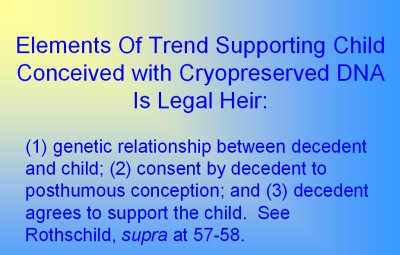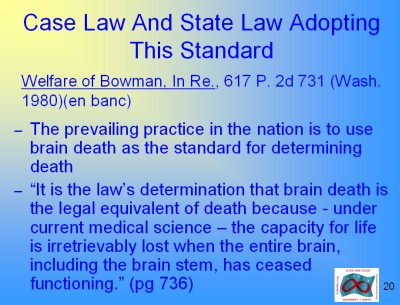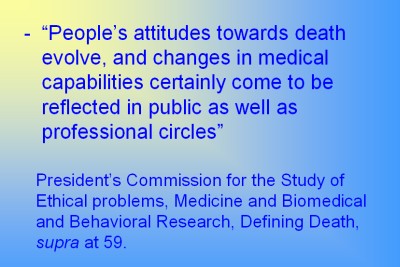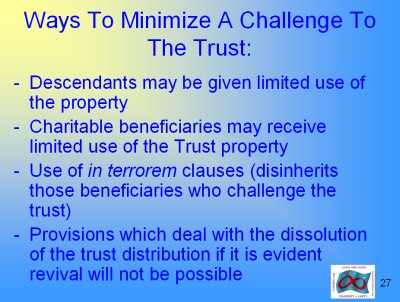Arguments Supporting the Legal Rights of People in and Revived from Biostasis
John P. Dedon, Esq.
Page 2 of 2
Third argument: Children born from frozen embryos are legal heirs. If that's the case, shouldn't cryonically-preserved people enjoy the same right?
I previously cited Mr. Rothchild. His outline refers to a line of developing cases. These cases are parallel to our cases; they are simply ahead of us because the medicine is ahead of us. The courts have concluded that if a child is born from the frozen DNA of a decedent, and it's conceived even with that frozen DNA after the death of the decedent, that child has the right to inherit.
For example, In Re Martin B. [1], is a recent case by the New York Supreme Court in 2007. It's consistent with a line of cases that are developing in the law that says there is no public policy that prohibits the conception of children with frozen DNA.

I tried to distill the elements of these cases to see how they relate to what we do. If you look at the cases dealing with frozen DNA, there is a genetic relationship between the decedent and the child. There is consent by the decedent to the conception and then the decedent agrees to support the child. Dad dies, his sperm is frozen, after his death it can be impregnated with the woman, and the child is conceived. That child then has the right to inherit.
What does that mean to us? Do we have a genetic relationship between the cryonically-preserved person and the revived person? Certainly. The cryonically-preserved person consents to be revived? That's obviously why they are being preserved.
The cryonically-preserved person has arranged for his or her support? That's what we're working on. Some have, maybe some haven't gotten there, but that's another element that can also be taken care of. Thus, by analogy we're trying to come in on all fours with these cases.
Fourth argument: The shift in the standard for determining death has moved away from the absence of breathing and toward a brain death concept. That started back in the early '80s when it was recommended by a presidential commission that “brain dead” is the way to measure when you are legally dead. There are court cases over the last several years that have supported that notion. It's relatively accepted that brain death is the standard that applies now when someone is legally dead.

What does that mean in the cryonic world? It can be argued that people that are being cryonically preserved maintain a level of brain activity or at least have the opportunity to maintain a level of brain activity that is not otherwise applicable if you're not being cryonically preserved.
Let us explore two different angles to that concept. One comes from Dr. Rothblatt [2], who has written about the concept of bemes [3] and the idea that you can download thoughts and impressions and pictures and other things. What you end up with is not just a history of yourself but perhaps even your personality and a presence that may then be used when a person is being revived.
There is a second angle to this, and it is more philosophical. The thought is if the standard has shifted over time regarding what constitutes death, shouldn’t there be an evolving standard that recognizes as the medicine and technology develops so too should the standard shift to recognize that people who are being preserved will ultimately be able to come back to life?

In that regard lets go back to the presidential commission in 1981 where they said, "People's attitudes toward death evolve and changes in medical capabilities certainly come to be reflected in public as well as professional circles." [4]
They weren't thinking of cryonics back in 1981, but certainly as they went from a breathing standard to a brain death standard what they talked about back then is applicable now as you look at our area of the law and our area of the medicine and how it continues to develop.
Those are the four arguments, any one of which we can rely on. As the law develops we would certainly be relying on all four and borrowing from all four in order to establish the precedent for why people who are being cryonically preserved enjoy certain rights.
Let us touch on one of the relevant aspects to determine whether children conceived with frozen DNA should be allowed to inherit. As I stated that area of the law can help us. One of the concepts was the ability to support oneself. This takes us back to these wealth preservation trusts and the idea that you can establish a trust that can continue while you're in biostasis [5] and assets will then be available when you are revived.
This is not directly on the topic, but to quickly touch on it, the concept is that there is a fundamental body of law that recognizes dynasty trusts. A number of states now do, so there is nothing unique about that. What we want to do is design a wealth preservation trust for a cryonically-preserved person to mirror the provisions that you would see in a typical dynasty trust. Unlike dynasty trusts, which distribute money to beneficiaries who are potentially unknown (grandchildren/great grandchildren), cryonic preservation trusts provide for the revived person.

With that in mind, there may be distributions that would be made annually or at least provide for the possibility of distributions. There could be some charitable distributions. We want to design a “typical” dynasty trust, but certainly the bulk of the assets would be available for you when you are revived.
Footnotes
1. Martin vs. US – In Re Martin B., 841 N.Y.S. 2d 207 (Surr. Ct. 2007), the court concluded that a child produced from the frozen DNA of a decedent, used postmortem with the surviving spouse, can inherit.
2. Dr. Rothblatt – Martine Rothblatt, J.D. Ph.D. started the satellite vehicle tracking and satellite radio industries and is the Chairman of United Therapeutics, a biotechnology company headquartered in Silver Springs, Maryland. Dr. Rothblatt is also the President of Terasem Movement, Inc. and has written several books, including The Apartheid of Sex, Two Stars for Peace, Unzipped Genes, and Your Life or Mine.
http://terasemcentral.org/about.html February 12, 2009 11:26AM EST
3. Bemes – fundamental, transmissible, mutate-able units of beingness; highly individual elements of personality, mannerisms, feelings, recollections, beliefs, values, and attitudes.
“On Genes, Memes, Bemes, and Conscious Things.” The Journal of Personal Cyberconsciousness. Volume 1, Issue 4 (2006). http://www.terasemjournals.org/PCJournal/... February 11, 2009 3:24PM EST
4. President’s Commission for the Study of Ethical problems, Medicine and Biomedical and Behavioral Research, Defining Death, supra at 59.
5. Biostasis - is the ability of an organism to tolerate environmental changes without having to actively adapt to them. The word is also used as a synonym for cryostasis or cryonics. It is found in organisms that live in habitats that may encounter unfavorable living conditions (ie. drought, freezing, a change in pH, pressure, or temperature).
http://en.wikipedia.org/wiki/Biostasis February 12, 2009 1:03PM EST
Bio
 John P. Dedon, Esq. is an estate planning, business, tax, and wealth preservation attorney. He has been in private practice since 1984, concentrating in federal taxation matters. John has been quoted extensively in newspapers throughout the country, such as the Washington Post and Chicago Tribune, on estate planning matters.
John P. Dedon, Esq. is an estate planning, business, tax, and wealth preservation attorney. He has been in private practice since 1984, concentrating in federal taxation matters. John has been quoted extensively in newspapers throughout the country, such as the Washington Post and Chicago Tribune, on estate planning matters.